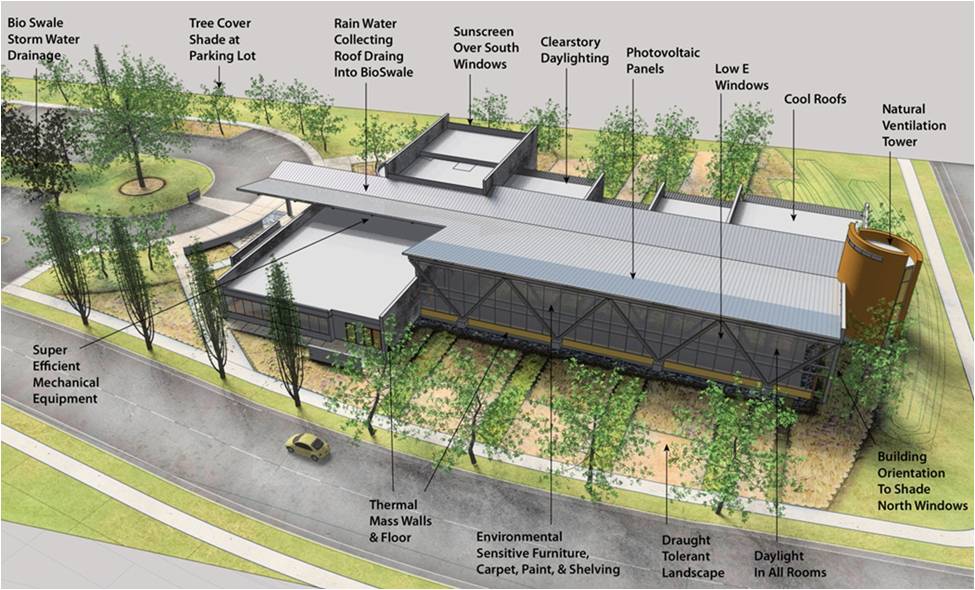The Valley Hi – North Laguna Library is a very high profile project for the Sacramento county public library system. The library is a water and energy efficient community building serving as an exemplary model of building design, establishing a comfortable environment for its patrons with reduced environmental impacts. The project consists of one single story building with a conditioned floor area of 20,200 ft2 and with an unconditioned floor area of 300 ft2. For the main library service area, the reading room is the largest room in the facility with almost 40% of the floor area. There is a children’s reading area, story time room, technology lab, teen area, learning room, and study centers. Supporting staff offices and a book handling room are in the library as well. The meeting room and café area will be on a separate operating schedule from the rest of the library due to community events held during after hours of normal library operation. The project will achieve a LEED NC v2.2 Gold Certification, with 8-points (39.5%) being associated with LEED EAc1.
Case Studies
Valley Hi North Laguna Library

Special Features
This project has a strong impact on the surrounding community both by improving the landscape of the area and by bringing vital services to those in need. A park is provided outside the library, and art exhibits are on permanent display outdoors. The focus of the construction was to reduce carbon emissions, yet provide a comfortable space for all patrons using the library. The project consists of rooftop solar domestic hot water panels, on-site storm water retention along with numerous other reduced carbon design elements. Compared to the ASHRAE 90.1-2004, App. G baseline building, the project is expected to save 147,120 kWh/yr of electricity and 1,730 therms of natural gas, avoiding 127,400-lbs CO2 equivalent emissions annually. The Sacramento area cools at nighttime during the summer with the “delta breeze” that blows up from the San Francisco bay area. A mechanical night flush system captures those cooler summer nights, flushing the building, and charging the high thermal mass walls. This shifts peak demand for the following day, reducing loads on the power plants. An additional advantage to the wall systems is for the concrete insulated sandwich panel, there is no thermal bridging through the wall system. Several energy efficient approaches are used with the HVAC design. Displacement ventilation diffusers were used at floor level for all perimeter locations and some interior zones receiving conditioned air. Many advantages exist for displacement ventilation. Warmer air is delivered, saving on energy usage through reduced compressor energy as well as an increase in economizer hours for “free” cooling. In addition, ventilation efficiency improves with displacement ventilation due to stratification created in the spaces so the occupants feel fresher. Conditioned air is delivered directly to the source where needed, instead of an alternative overhead system where air is completely mixed. This project utilizes some overhead supply diffusers; however most of the conditioning occurs through the displacement ventilation. The VAV main air conditioning unit is evaporatively condensed, where water is evaporated directly from the condensing coils for better heat rejection. The community room required a separate air conditioning unit. The energy use associated with conditioning the high ventilation requirements of the space is reduced with a heat recovery wheel for both winter and summer time conditioning. A small package DX VAV is used for the food court area. A condensing boiler is used to deliver 160⁰F heating hot water to the reheat coils of the main ACU and the linear convectors in the reading area room.

Water Conservation
Water saving features included sensor operated flush valves for water closets and urinals. This resulted in a reduction in Water Use LEED credit WEc3 of 46.3% or 49,800 gallons/yr, compared to the baseline.
Electrical
The lighting design utilized efficient lamping averaging 0.87 W/sqft. The ASHRAE 90.1-2004 building area method is 1.3 W/sq ft. Lighting loads were minimized by selections of high efficacy lighting fixtures to provide most of the ambient illumination. Lower wattage lamps and fewer total fixtures were able to be used by the sole use of T8, high color temperature, high CRI lamps selected over lower color temperatures providing a perception of brighter spaces with lower total power used. Occupancy sensors turn off lighting when areas are not in use. Dual level switching was used in all spaces over 250 square feet allowing lighting levels to be reduce by 50% in a pattern that allows full function of spaces with reduced power consumption. Lighting installed within 15 linear feet of effective translucent surfaces (windows and skylights) have separate switching from the rest of the interior spaces allowing lighting to be controlled off when it is not needed. South facing clerestory walls and a large north facing glazing provides ample daylighting.
Environmental Impact
The air handlers have been specified with R410A which is not a CFC and is non-ozone depleting. Utilizing evaporative cooling for a significant portion of the cooling reduces the energy consumption and use of fossil fuels or non-renewable resources. The solar hot water systems utilize solar energy for heating the hot water.
Cost Effectiveness
The incremental capital cost of the energy efficiency measures was approximately $306,400 and the associated annual energy savings is $18,200. The total replacement cost every 20 yrs of the incremental systems is approximately $34,300. The simple payback for the building systems is 17-years.

